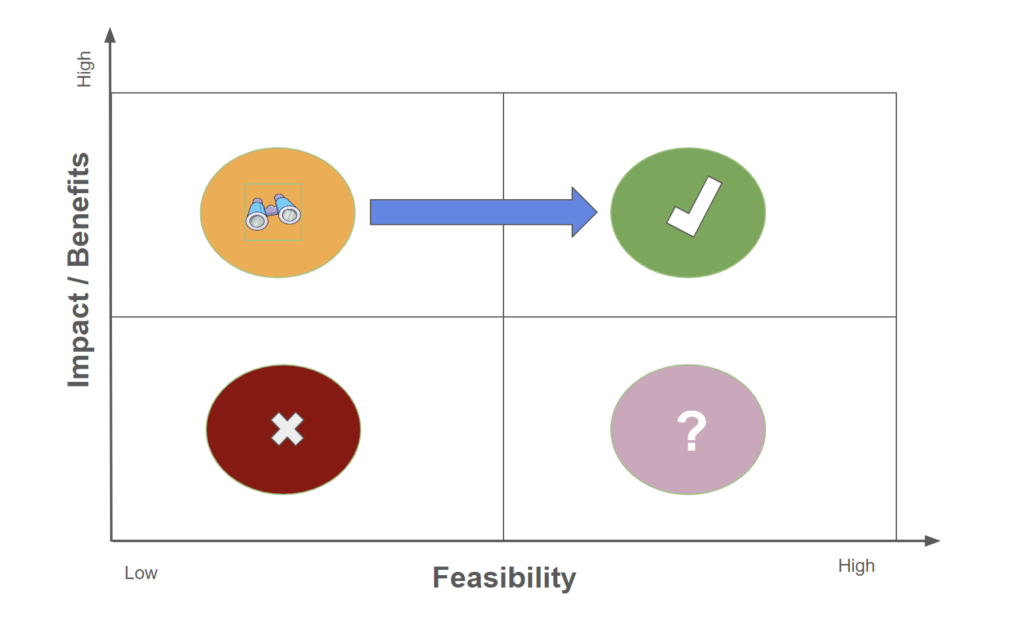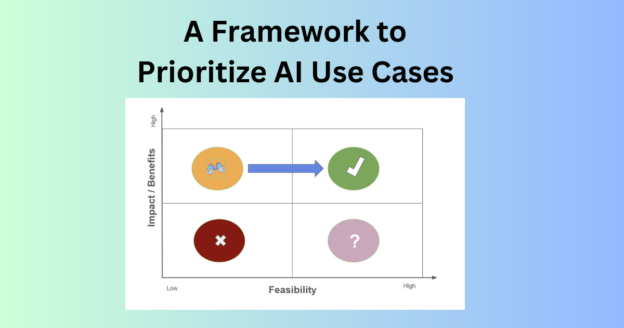Prioritizing AI use cases is important.
That’s because while AI use cases can be targeted to influence revenue, CX, costs, and service, not all of them are right for a business all the time. Read this post on creating an AI strategy.
So, it’s useful to create a scoring method that enables us to transparently prioritize AI use cases:
- Identify the use cases with maximum impact
- Prepare for the future implementations of high ROI initiatives
PS: If you already have an AI use case, use this AI Idea Scorecard tool to score it to see if it should get the green light.
The Overall Framework to Prioritize AI Use Cases
The best things are pretty simple. And so is this framework.
Its simply a 2×2 matrix and can be used universally.
- Impact – what’s the size of the ROI, is it aligned to the business, etc.
- Feasibility – how easily can we do it, how much time, etc.

How to Use It?
There are a set of 8 criteria to help us score our use cases on level.
After scoring we get 1 of 3 results:
- Green Light: the initiative scores towards the top right of the matrix.
- Proceed with caution: Scores somewhere in the middle. Analyze further and then proceed.
- Stop!: the initiative scores are skewed to the left and bottom. It’d be good to reevaluate both impact and feasibility both.
And here are criteria on which projects are rated:
- Alignment with Business Objectives: Consider how the idea supports stated business objectives in the short and long term.
- Expected Value: Consider factors such as potential financial impact – new revenue, new customers, or efficiency gains. Consider competitive advantage and customer satisfaction improvements. The expected value should take into account risk and costs too.
- Data Availability: How accessible, relevant, and high-quality is the data required for this idea? Assess data sources, how easy to integrate they are, completeness of data for your model, cleanliness or quality of data, and historical data availability.
- Operationalization Difficulty: Ultimately the insights generated need to be integrated with operational applications and people. Think of technical challenges and ease of integration with existing systems using APIs or other ways, resource requirements, and business process changes or trainings for operations staff.
- Scalability: How scalable is the proposed solution to apply to multiple use cases? Evaluate how broadly can this idea be adopted. For example, can this work for multiple businesses, customer segments, etc.? This is not crucial depending on the use case but can be a factor if you are a big enterprise.
- Risk and Compliance: What are the potential risks and regulatory compliance issues associated with the implementation? Some models are sensitive. Consider data privacy, security, industry regulations, and any ethical concerns. It’s important to address these.
- Differentiation: To what extent does the idea introduce ways for the the company to create differentiation Assess novelty of this use case and how this can uplift the brand as well – uniqueness, and differentiation from competitors are two common aspects.
- Stakeholder Support: What is the level of buy-in and support from key stakeholders within the organization? Consider executive sponsorship, cross-departmental collaboration, and user adoption. Sometimes stakeholders may have latent concerns so be sure to look under the surface – does it affect head count, does it shift balance of power, does it derail a pet project, etc.
Next Steps
This method to Prioritize AI Use Cases may seem simple, but prioritization always has grey areas. An obviously high value and high feasibility project may face headwinds due to other considerations such as changes in business, people dynamics, and so on.
In addition, sometimes low feasibility projects may need to be fast-tracked because of strategic importance. For example, upcoming launch of a new product or a new business model.
Nevertheless, it’s a useful exercise to know where you are. It provides you with valuable insights and inputs to brace for change.
Use this AI Idea Scorecard tool to rate your use case on all 8 dimensions and get the overall score as well. Confidential information is not needed.
If you’d like to brainstorm then Connect with me.

